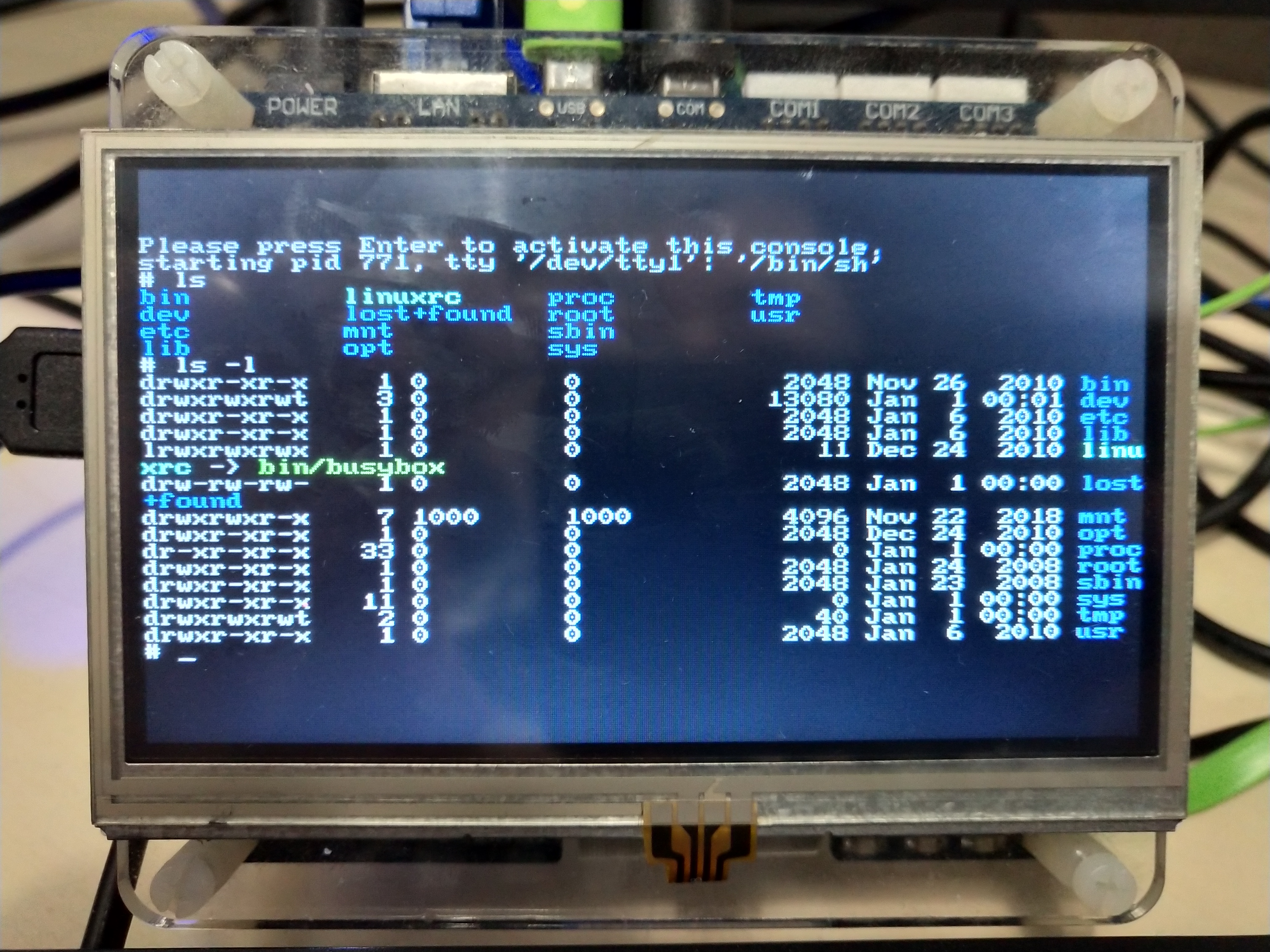学习目标:编写LCD驱动程序,熟悉根据芯片手册分析时序图,配置寄存器,并测试LCD程序。
一、LCD驱动程序编写
步骤:
1)分配fb_info结构体
2)设置fb_info结构体
a. 固定参数
b. 可变参数
c. 操作函数
--设置调色板
d. fb_info的其它成员
--设置显存
3)硬件相关的操作
--配置GPIO用于用于LCD
--根据手册设置LCD控制器寄存器
--分配显存,并把地址告诉LCD控制器
4) 注册fb_info结构体
二、源码:
1 #include <linux/module.h> 2 #include <linux/kernel.h> 3 #include <linux/errno.h> 4 #include <linux/string.h> 5 #include <linux/mm.h> 6 #include <linux/slab.h> 7 #include <linux/delay.h> 8 #include <linux/fb.h> 9 #include <linux/init.h> 10 #include <linux/dma-mapping.h> 11 #include <linux/interrupt.h> 12 #include <linux/workqueue.h> 13 #include <linux/wait.h> 14 #include <linux/platform_device.h> 15 #include <linux/clk.h> 16 #include <asm/io.h> 17 #include <asm/uaccess.h> 18 #include <asm/div64.h> 19 #include <asm/mach/map.h> 20 #include <asm/arch/regs-lcd.h> 21 #include <asm/arch/regs-gpio.h> 22 #include <asm/arch/fb.h> 23 24 //调色板 25 static int s3c_lcdfb_setcolreg(unsigned int regno, unsigned int red, 26 unsigned int green, unsigned int blue, 27 unsigned int transp, struct fb_info *info); 28 29 //lcd寄存器 30 struct lcd_regs { 31 unsigned long lcdcon1; 32 unsigned long lcdcon2; 33 unsigned long lcdcon3; 34 unsigned long lcdcon4; 35 unsigned long lcdcon5; 36 unsigned long lcdsaddr1; 37 unsigned long lcdsaddr2; 38 unsigned long lcdsaddr3; 39 unsigned long redlut; 40 unsigned long greenlut; 41 unsigned long bluelut; 42 unsigned long reserved[9]; 43 unsigned long dithmode; 44 unsigned long tpal; 45 unsigned long lcdintpnd; 46 unsigned long lcdsrcpnd; 47 unsigned long lcdintmsk; 48 unsigned long lpcsel; 49 }; 50 51 static struct fb_ops s3c_lcdfb_ops = { 52 .owner = THIS_MODULE, 53 .fb_setcolreg = s3c_lcdfb_setcolreg, //设置调色板 54 .fb_fillrect = cfb_fillrect, 55 .fb_copyarea = cfb_copyarea, 56 .fb_imageblit = cfb_imageblit, 57 }; 58 59 static struct fb_info *s3c_lcd; 60 static volatile unsigned long *gpbcon; 61 static volatile unsigned long *gpbdat; 62 static volatile unsigned long *gpccon; 63 static volatile unsigned long *gpdcon; 64 static volatile unsigned long *gpgcon; 65 static volatile struct lcd_regs* lcd_regs; 66 static u32 pseudo_palette[16]; 67 68 /* from pxafb.c */ 69 static inline unsigned int chan_to_field(unsigned int chan, struct fb_bitfield *bf) 70 { 71 chan &= 0xffff; 72 chan >>= 16 - bf->length; 73 return chan << bf->offset; 74 } 75 76 //设置调色板,供内核使用 77 static int s3c_lcdfb_setcolreg(unsigned int regno, unsigned int red, 78 unsigned int green, unsigned int blue, 79 unsigned int transp, struct fb_info *info) 80 { 81 unsigned int val; 82 83 if (regno > 16) 84 return 1; 85 86 /* 用red,green,blue三原色构造出val,根据info结构体中设置的偏移,val最终是16位象素 */ 87 val = chan_to_field(red, &info->var.red); 88 val |= chan_to_field(green, &info->var.green); 89 val |= chan_to_field(blue, &info->var.blue); 90 91 //((u32 *)(info->pseudo_palette))[regno] = val; 92 pseudo_palette[regno] = val; //val放到调色板数组中 93 return 0; 94 } 95 96 static int lcd_init(void) 97 { 98 /* 1. 分配一个fb_info */ 99 s3c_lcd = framebuffer_alloc(0, NULL); 100 101 /* 2. 设置 */ 102 /* 2.1 设置固定的参数 */ 103 strcpy(s3c_lcd->fix.id, "mylcd"); 104 s3c_lcd->fix.smem_len = 240*320*16/8; //显存的长度=分辨率*每象素字节数 每个像素用16位表示(5:6:5); 105 s3c_lcd->fix.type = FB_TYPE_PACKED_PIXELS; //默认 106 s3c_lcd->fix.visual = FB_VISUAL_TRUECOLOR; /* TFT 真彩色*/ 107 s3c_lcd->fix.line_length = 240*2; //每行的长度,以字节为单位 108 109 /* 2.2 设置可变的参数 */ 110 s3c_lcd->var.xres = 240; 111 s3c_lcd->var.yres = 320; 112 s3c_lcd->var.xres_virtual = 240; 113 s3c_lcd->var.yres_virtual = 320; 114 s3c_lcd->var.bits_per_pixel = 16; //每个象素使用多少位 16bit 115 116 /* RGB:565 */ 117 s3c_lcd->var.red.offset = 11; 118 s3c_lcd->var.red.length = 5; 119 120 s3c_lcd->var.green.offset = 5; 121 s3c_lcd->var.green.length = 6; 122 123 s3c_lcd->var.blue.offset = 0; 124 s3c_lcd->var.blue.length = 5; 125 126 s3c_lcd->var.activate = FB_ACTIVATE_NOW;//使设置的值立即生效 127 128 129 /* 2.3 设置操作函数 */ 130 s3c_lcd->fbops = &s3c_lcdfb_ops; 131 132 /* 2.4 其他的设置 */ 133 s3c_lcd->pseudo_palette = pseudo_palette;//存放调色板所调颜色的数组 134 //s3c_lcd->screen_base = ; /* 显存的虚拟地址 */ 135 s3c_lcd->screen_size = 240*324*16/8;//显存的大小 136 137 /* 3. 硬件相关的操作 */ 138 /* 3.1 配置GPIO用于LCD */ 139 gpbcon = ioremap(0x56000010, 8); 140 gpbdat = gpbcon+1; 141 gpccon = ioremap(0x56000020, 4); 142 gpdcon = ioremap(0x56000030, 4); 143 gpgcon = ioremap(0x56000060, 4); 144 145 *gpccon = 0xaaaaaaaa; /* GPIO管脚用于VD[7:0],LCDVF[2:0],VM,VFRAME,VLINE,VCLK,LEND */ 146 *gpdcon = 0xaaaaaaaa; /* GPIO管脚用于VD[23:8] */ 147 148 *gpbcon &= ~(3); /* GPB0设置为输出引脚 */ 149 *gpbcon |= 1; 150 *gpbdat &= ~1; /* 输出低电平,关闭背光* */ 151 152 *gpgcon |= (3<<8); /* GPG4用作LCD_PWREN信号*/ 153 154 /* 3.2 根据LCD手册设置LCD控制器, 比如VCLK的频率等 */ 155 lcd_regs = ioremap(0x4D000000, sizeof(struct lcd_regs)); 156 157 /* bit[17:8]: VCLK = HCLK / [(CLKVAL+1) x 2], LCD手册P14 158 * 10MHz(100ns) = 100MHz / [(CLKVAL+1) x 2] 159 * CLKVAL = 4 160 * bit[6:5]: 0b11, TFT LCD 161 * bit[4:1]: 0b1100, 16 bpp for TFT 162 * bit[0] : 0 = Disable the video output and the LCD control signal. 163 */ 164 lcd_regs->lcdcon1 = (4<<8) | (3<<5) | (0x0c<<1); 165 166 #if 1 167 /* 垂直方向的时间参数 168 * bit[31:24]: VBPD, VSYNC之后再过多长时间才能发出第1行数据 169 * LCD手册 T0-T2-T1=4 170 * VBPD=3 171 * bit[23:14]: 多少行, 320, 所以LINEVAL=320-1=319 172 * bit[13:6] : VFPD, 发出最后一行数据之后,再过多长时间才发出VSYNC 173 * LCD手册T2-T5=322-320=2, 所以VFPD=2-1=1 174 * bit[5:0] : VSPW, VSYNC信号的脉冲宽度, LCD手册T1=1, 所以VSPW=1-1=0 175 */ 176 lcd_regs->lcdcon2 = (3<<24) | (319<<14) | (1<<6) | (0<<0); 177 178 179 /* 水平方向的时间参数 180 * bit[25:19]: HBPD, VSYNC之后再过多长时间才能发出第1行数据 181 * LCD手册 T6-T7-T8=17 182 * HBPD=16 183 * bit[18:8]: 多少列, 240, 所以HOZVAL=240-1=239 184 * bit[7:0] : HFPD, 发出最后一行里最后一个象素数据之后,再过多长时间才发出HSYNC 185 * LCD手册T8-T11=251-240=11, 所以HFPD=11-1=10 186 */ 187 lcd_regs->lcdcon3 = (16<<19) | (239<<8) | (10<<0); 188 189 /* 水平方向的同步信号 190 * bit[7:0] : HSPW, HSYNC信号的脉冲宽度, LCD手册T7=5, 所以HSPW=5-1=4 191 */ 192 lcd_regs->lcdcon4 = 4; 193 //lcd寄存器配置的另一种写法 194 #else 195 lcd_regs->lcdcon2 = S3C2410_LCDCON2_VBPD(5) | 196 S3C2410_LCDCON2_LINEVAL(319) | 197 S3C2410_LCDCON2_VFPD(3) | 198 S3C2410_LCDCON2_VSPW(1); 199 200 lcd_regs->lcdcon3 = S3C2410_LCDCON3_HBPD(10) | 201 S3C2410_LCDCON3_HOZVAL(239) | 202 S3C2410_LCDCON3_HFPD(1); 203 204 lcd_regs->lcdcon4 = S3C2410_LCDCON4_MVAL(13) | 205 S3C2410_LCDCON4_HSPW(0); 206 207 #endif 208 /* 信号的极性 209 * bit[11]: 1=565 format 210 * bit[10]: 0 = The video data is fetched at VCLK falling edge 211 * bit[9] : 1 = HSYNC信号要反转,即低电平有效 212 * bit[8] : 1 = VSYNC信号要反转,即低电平有效 213 * bit[6] : 0 = VDEN不用反转 214 * bit[3] : 0 = PWREN输出0 215 * bit[1] : 0 = BSWP 216 * bit[0] : 1 = HWSWP 2440手册P413 217 */ 218 lcd_regs->lcdcon5 = (1<<11) | (0<<10) | (1<<9) | (1<<8) | (1<<0); 219 220 /* 3.3 分配显存(framebuffer), 并把地址告诉LCD控制器 */ 221 s3c_lcd->screen_base = dma_alloc_writecombine(NULL, s3c_lcd->fix.smem_len, &s3c_lcd->fix.smem_start, GFP_KERNEL); 222 223 lcd_regs->lcdsaddr1 = (s3c_lcd->fix.smem_start >> 1) & ~(3<<30); //对应内存起始地址的 A[30:1] ,则起始地址右移1位,&0x3fffffff 共30位 224 lcd_regs->lcdsaddr2 = ((s3c_lcd->fix.smem_start + s3c_lcd->fix.smem_len) >> 1) & 0x1fffff; 225 lcd_regs->lcdsaddr3 = (240*16/16); /* 一行的长度(单位: 2字节) */ 226 227 //s3c_lcd->fix.smem_start = xxx; /* 显存的物理地址 */ 228 /* 启动LCD */ 229 lcd_regs->lcdcon1 |= (1<<0); /* 使能LCD控制器 */ 230 lcd_regs->lcdcon5 |= (1<<3); /* 使能LCD本身 */ 231 *gpbdat |= 1; /* 输出高电平, 使能背光 */ 232 233 /* 4. 注册 */ 234 register_framebuffer(s3c_lcd); 235 return 0; 236 } 237 static void lcd_exit(void) 238 { 239 unregister_framebuffer(s3c_lcd); 240 lcd_regs->lcdcon1 &= ~(1<<0); /* 关闭LCD本身 */ 241 *gpbdat &= ~1; /* 关闭背光 */ 242 dma_free_writecombine(NULL, s3c_lcd->fix.smem_len, s3c_lcd->screen_base, s3c_lcd->fix.smem_start);//3为虚拟地址 243 iounmap(lcd_regs); 244 iounmap(gpbcon); 245 iounmap(gpccon); 246 iounmap(gpdcon); 247 iounmap(gpgcon); 248 framebuffer_release(s3c_lcd); 249 } 250 module_init(lcd_init); 251 module_exit(lcd_exit); 252 MODULE_LICENSE("GPL");
LCD寄存器配置分析:
1、lcdcon1 寄存器配置
1 /* bit[17:8]: VCLK = HCLK / [(CLKVAL+1) x 2], LCD手册P14 2 * 10MHz(100ns) = 100MHz / [(CLKVAL+1) x 2] 3 * CLKVAL = 4 4 * bit[6:5]: 0b11, TFT LCD 5 * bit[4:1]: 0b1100, 16 bpp for TFT 6 * bit[0] : 0 = Disable the video output and the LCD control signal. 7 */ 8 lcd_regs->lcdcon1 = (4<<8) | (3<<5) | (0x0c<<1);
查看2440说明书,找到lcdcon1 寄存器,确定每一位的取值:
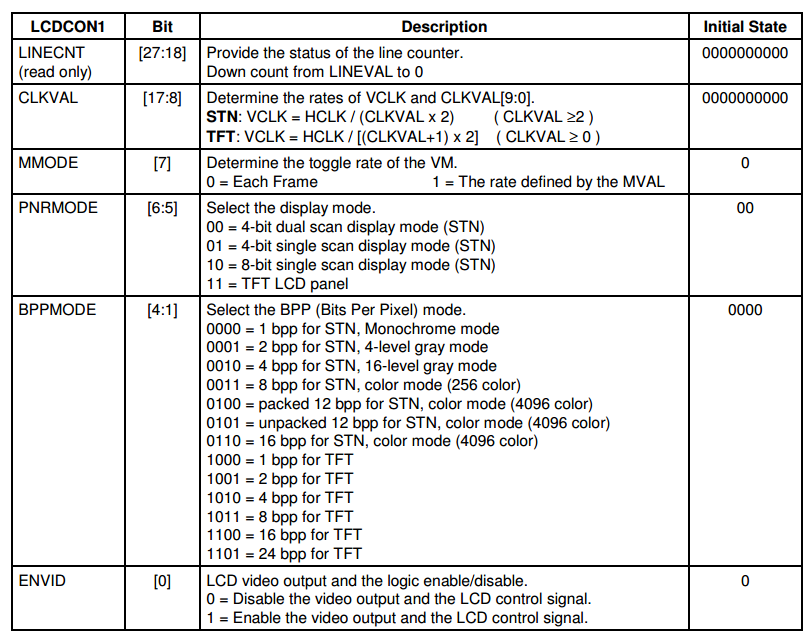
1)bit[17:8] VCLK = HCLK / [(CLKVAL+1) x 2]计算CLKVAL的值,首先使用# dmesg命令查看内核打印信息,获取HCLK为100MHz。
查看液晶屏的芯片手册Clock cycle time 可知:VCLK = 100ns ==> 10MHz,从而可知 10=100/[(CLKVAL+1) x 2]==> CLKVAL=4 bit[17:8]就是4;
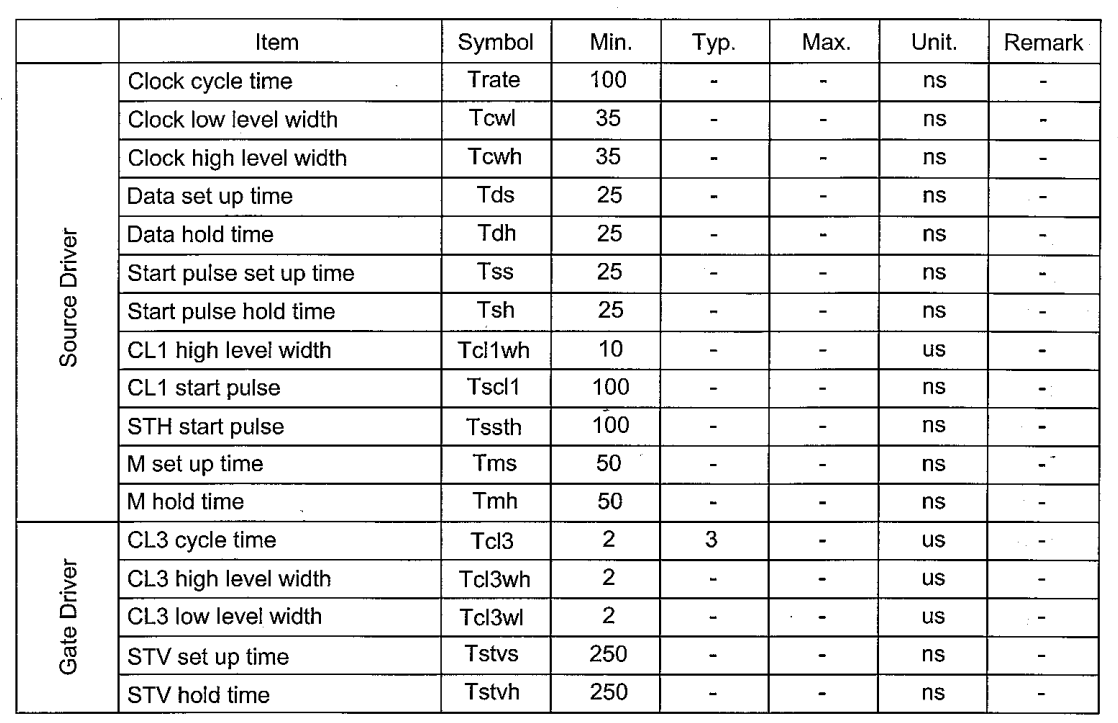
2)bit[6:5]: 0b11, TFT LCD;
3)bit[0] : 0 LCD信号输出使能位禁止。
2、lcdcon2
1 /* 垂直方向的时间参数 2 * bit[31:24]: VBPD, VSYNC之后再过多长时间才能发出第1行数据 3 * LCD手册 T0-T2-T1=4 4 * VBPD=3 5 * bit[23:14]: 多少行, 320, 所以LINEVAL=320-1=319 6 * bit[13:6] : VFPD, 发出最后一行数据之后,再过多长时间才发出VSYNC 7 * LCD手册T2-T5=322-320=2, 所以VFPD=2-1=1 8 * bit[5:0] : VSPW, VSYNC信号的脉冲宽度, LCD手册T1=1, 所以VSPW=1-1=0 9 */ 10 lcd_regs->lcdcon2 = (3<<24) | (319<<14) | (1<<6) | (0<<0);
lcdcon2 寄存器,确定每一位的取值:
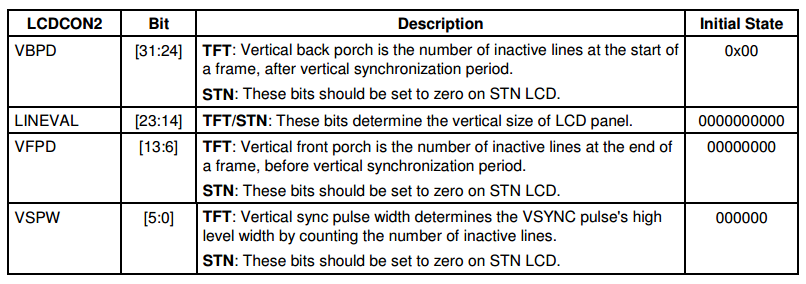
1) * bit[31:24]: 垂直方向的时间参数 VBPD, 即VSYNC之后再过多长时间才能发出第1行数据。
查看2440 LCD控制器的手册:
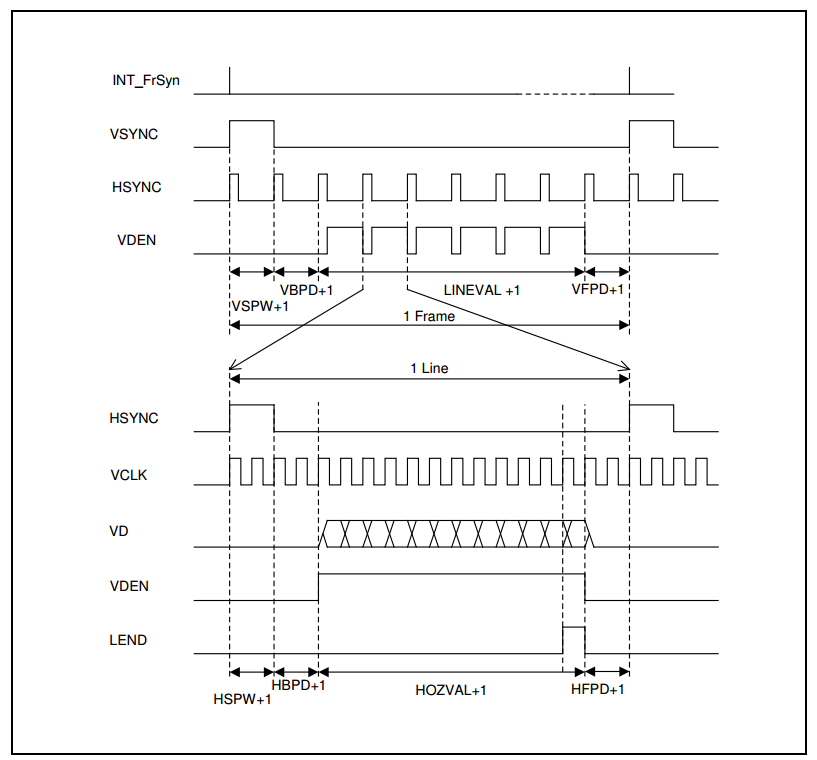
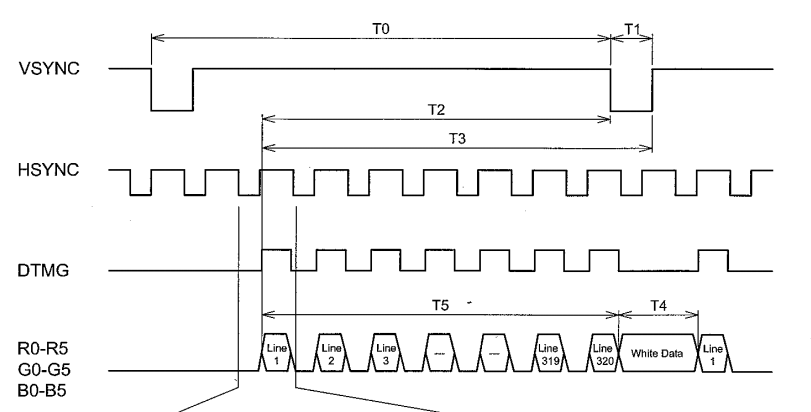
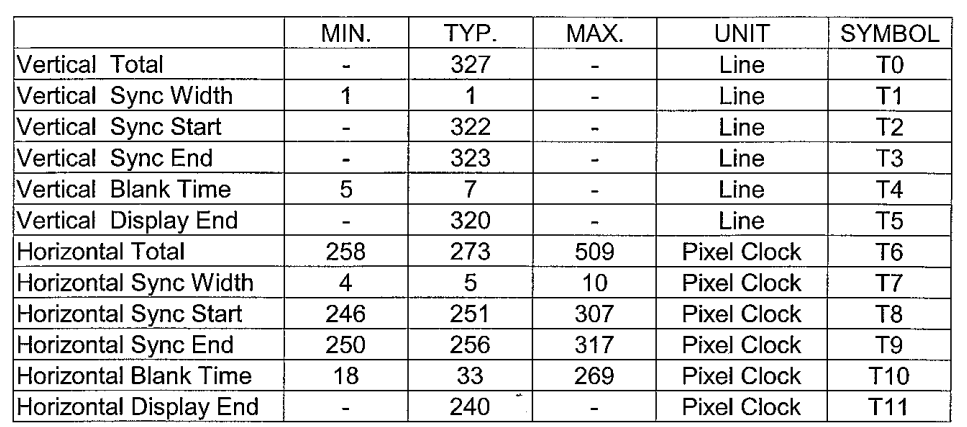
由上图可知:
VFPD+1=T2-T5=322-320, VFPD=1
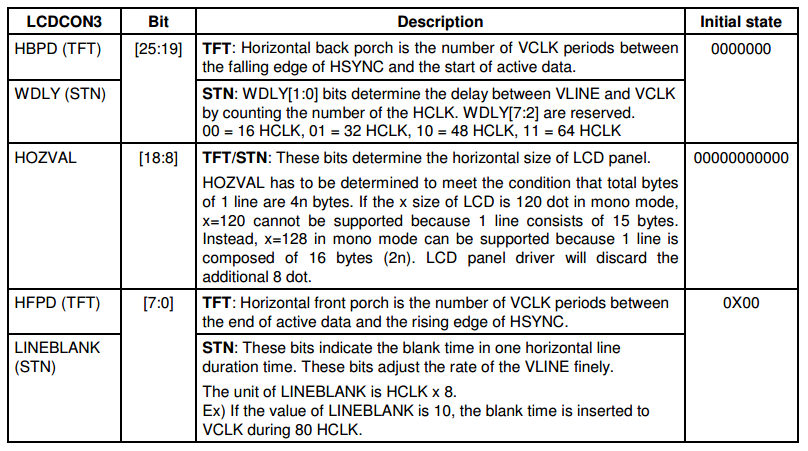
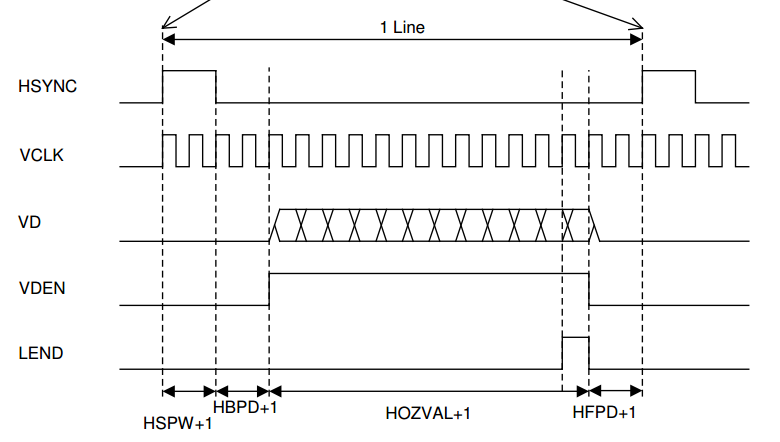

2) bit[18:8]: 多少列, 240, 所以HOZVAL=240-1=239
3) bit[7:0] : HFPD, 发出最后一行里最后一个象素数据之后,再过多长时间才发出HSYNC
HFPD+1=T8-T11=251-240=11, 所以HFPD=10
4、lcdcon4

* bit[7:0] : HSPW, HSYNC信号的脉冲宽度,HSPW+1=T7,HSPW=4
*/
三、编译测试
第一种方法:
1) make menuconfig去掉原来的驱动程序
-->Device Drivers
-->Graphics support
<M>S3C2410 LCD framebuffer support
2) 编译内核和模块
# make uImage
# make modules //把用到的程序编译成模块运行
3)编译lcd驱动为模块,将生成的lcd.ko和driver/video目录下用到的cfbcopyarea.ko、cfbfillrect.ko、 cfbimgblt.ko (lcd驱动程序中的fb_ops会用到)拷贝到/work/nfs_root/first_fs/lcd_test目录下。
4) 烧写uImage并启动开发板,并加载模块:
# nfs 30000000 10.70.12.103:/work/nfs_root/uImage_nolcd
# insmod cfbcopyarea.ko
# insmod cfbfillrect.ko
# insmod cfbimgblt.ko
# insmod lcd.ko
使用# ls /dev/fb* ,可以看到设备节点:/dev/fb0.
5) echo hello > /dev/tty1 // 可以在LCD上看见hello
cat lcd.ko > /dev/fb0 // 花屏
第二种测试方法:
1)修改/etc/inittab (添加:tty1::askfirst:-/bin/sh) 输出到tty1(对应为显示屏)//将/bin/sh信息输出到tty1中;
类似于:s3c2410_serial0::askfirst:-/bin/sh 输出到串口。
用新内核重启开发板
insmod cfbcopyarea.ko
insmod cfbfillrect.ko
insmod cfbimgblt.ko
insmod lcd.ko
insmod buttons.ko
可以看到Please。。。。。。。。。等一行字符
接着,将以前的USB键盘驱动,加载:# insmod ../usb_keyboard.ko
插上键盘后,可以在LCD显示终端控制信息:
